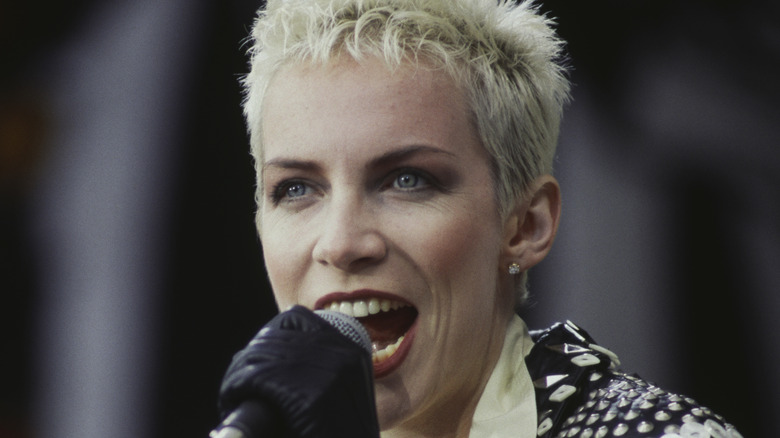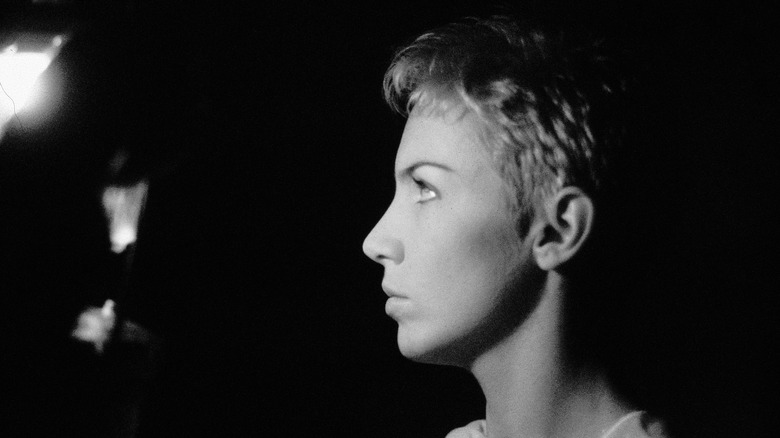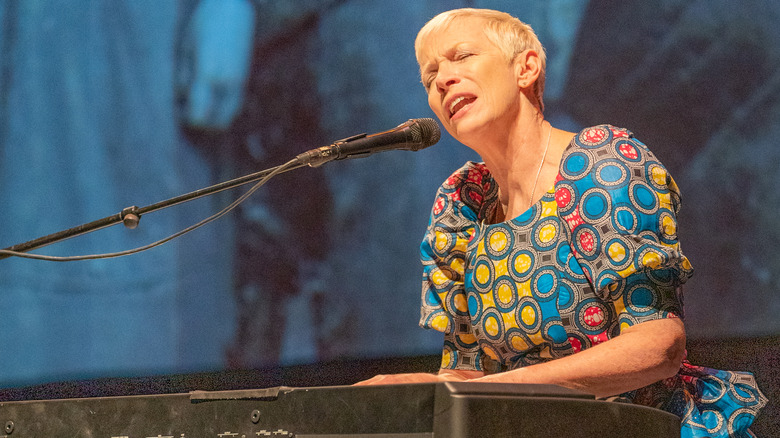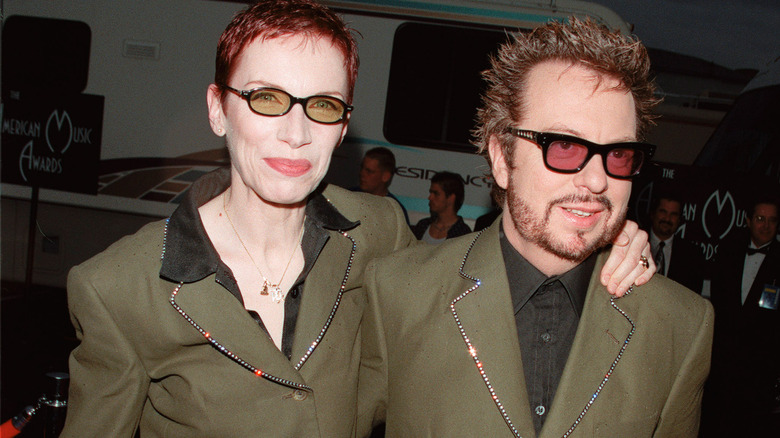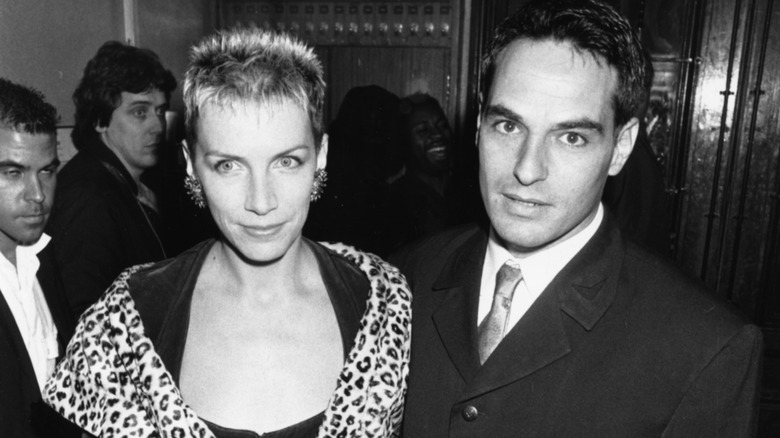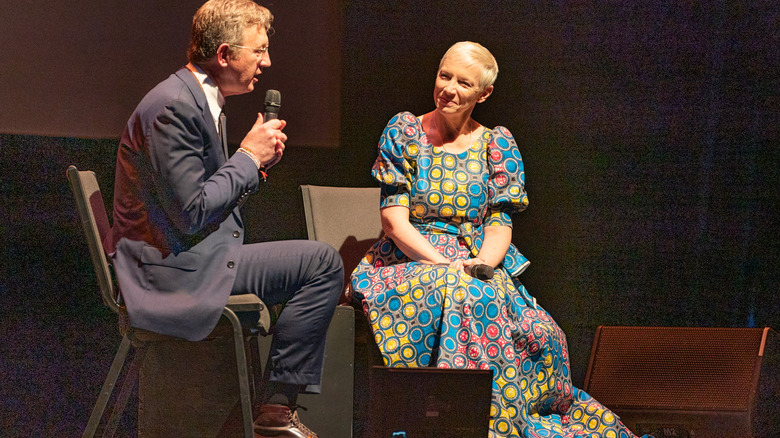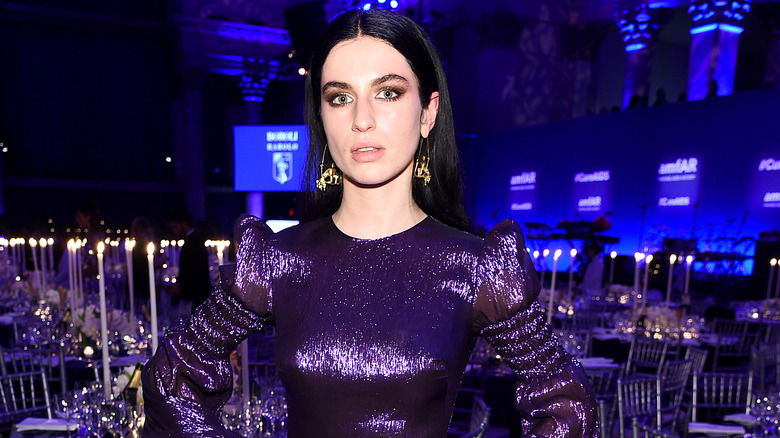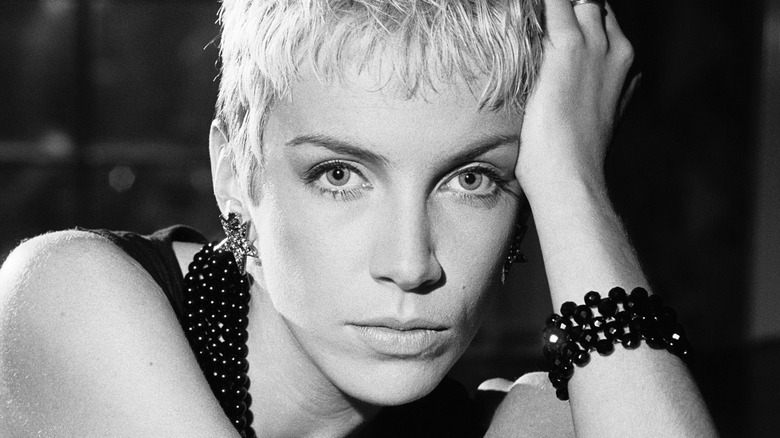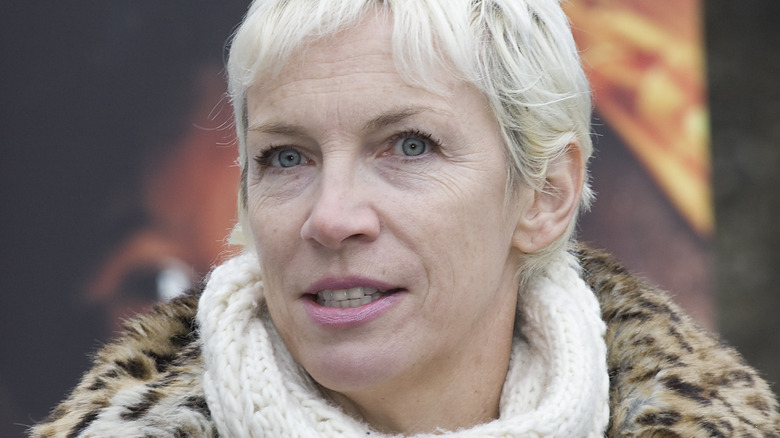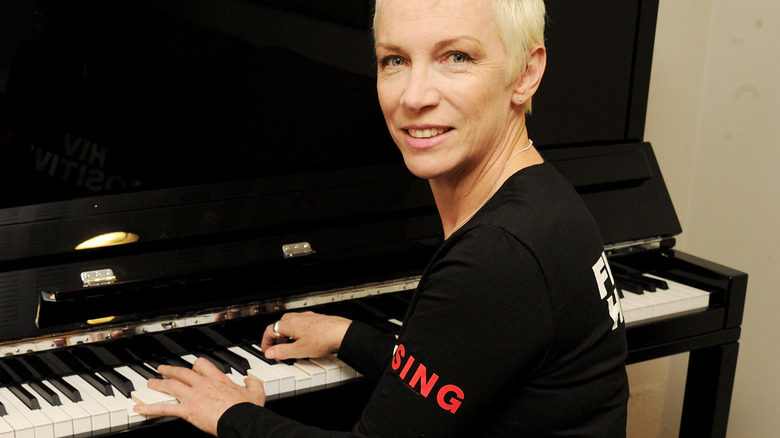Tragic Details About Annie Lennox
It's hard to believe that Eurythmics were spurned twice from the Rock & Roll Hall of Fame. After being nominated two times, Rolling Stone reported in 2022 that the duo, comprised of Annie Lennox and Dave Stewart, was to finally get its well-deserved spot in history. When they launched themselves into the cultural consciousness in the 1980s, it was clear they were ahead of their time. Critics didn't know what to make of their sound, their synthesizers, their innovative style, or Lennox's gender-fluid appearance that forced many to do a double take. But it didn't matter — fans eventually caught on. Although they haven't toured in 20 years and their last album came in 1999 with "Peace," they finally received long-overdue praise. The same year, they were also inducted into the Songwriters Hall of Fame.
Annie Lennox said the recognition was like coming full circle for the duo, a fitting end to decades of success together. But she had her own successful solo career after Eurythmics, producing six albums of her own and several hit singles, along with winning four Grammys and an Oscar, details Planet Radio. On the surface, her career has been an unqualified success, but Lennox has certainly experienced many dark moments to offset the brighter ones. Read on to learn tragic details about music icon Annie Lennox.
She regularly suffered from depression growing up
No one said that Scotland was a sunny place. Just ask Annie Lennox, who suffered from seasonal affective disorder (SAD) growing up from the lack of sunlight the region saw in the winter months, according to the Great Scot podcast (via The Times). Lennox said she had bad bouts of depression living in Aberdeen and blamed it on the city's dreary climate. She's not alone. SAD is a relatively common disorder in the U.K. and Scotland and has even forced some to find a home elsewhere, reports the Daily Record. And that's exactly what Lennox did. She made a home in sunny Los Angeles for exactly this reason and appreciates the long days it offers.
But depression has been a lifelong struggle for Lennox. Aside from the seasonal depression, she described her childhood home as not a particularly happy one since life wasn't easy for anyone amid their working-class lifestyle, according to The Times. Depression continued as she became an adult, and Lennox soon realized what many artists do: her best work came from despondency. For her, music was a way to escape those mental struggles, and since she settled down to a happy life with a new husband in 2012, she hasn't produced anything new. A bittersweet problem, for sure.
If you or someone you know needs help with mental health, please contact the Crisis Text Line by texting HOME to 741741, call the National Alliance on Mental Illness helpline at 1-800-950-NAMI (6264), or visit the National Institute of Mental Health website.
Lennox was unhappy at the Royal Academy of Music
Annie Lennox had a huge jumpstart to her music career with an acceptance to the Royal Academy of Music in London at age 17, per a column she wrote for The Guardian. But it didn't last. For one, she was there to play the flute, "which turned out to be both a blessing and a curse," she wrote. She eventually rejected the schooling and found more liberation as a musician when it came to her voice. Lennox explained her music school struggles when she received an Honorary Doctorate from the Academy in 2017 — 46 years after attending as a student. In her speech, she described herself wandering from home to home and working menial and odd jobs in order to support herself as a student only to discover that she had no future with the flute (via Annie Lennox.com).
The experience must have been a disappointing one; she realized her talents weren't good enough, and she wouldn't be able to land a seat with an orchestra. But, obviously, that epiphany led to greener pastures, and as she related to the graduating students during her speech, Lennox never doubted that her passions lay with music.
Her start with Eurythmics was a disaster
Eurythmics have gone on to have several hit singles, an album that ranks among Rolling Stone's 500 Greatest Albums of All Time, and a song that never seems to age with "Sweet Dreams," per Rock & Roll Hall of Fame. Of course, they are 2022 inductees into the Rock & Roll Hall of Fame, but like every great story about an artist making it big, the duo had a very rocky start and nearly vanished early. It was 1981, and the band released their debut album, "In the Garden." As The Press and Journal notes, none of their singles made a splash, and their reps at RCA evidently didn't find the album worthwhile enough for release in the United States. They went on tour anyway but received no help to haul their music and sound equipment from one town to another. They had to drive through a blizzard, and to make matters worse, they learned they were dropped by RCA.
This led to an emotional and career downward spiral, and Annie Lennox felt it keenly. According to an interview with The Face (via The Press and Journal), she said she began suffering from agoraphobia and severe depression. This dark period ended when her main Eurythmics collaborator, Dave Stewart, reached out with new, promising material. They managed to find funding, and one thing led to another. Or rather, it led to "Sweet Dreams" and a decade of success.
If you or someone you know needs help with mental health, please contact the Crisis Text Line by texting HOME to 741741, call the National Alliance on Mental Illness helpline at 1-800-950-NAMI (6264), or visit the National Institute of Mental Health website.
Lennox encountered misogyny as a young woman
Annie Lennox is quite familiar with misogyny. She experienced it growing up in the 1960s, and although the counterculture movement was at hand, the overwhelming expectations of women in a patriarchal society left an impression on her. In an interview with Larry King Now, Lennox recalled an overt antagonism from men when she was a teenager and an overarching disrespect toward women. Eurythmics collaborator Dave Stewart can account for some of this. He said that he first met Lennox when she had long hair and wore dresses. Her drastic style change toward her trademark androgynous look was driven by sexism in the punk world. Lennox knew she would have invited derision by wearing feminine clothing on stage, according to The Guardian.
Lennox admitted to Larry King that much of the sexist behavior she saw before is no longer acceptable, but she's as much of a feminist today as she ever was. She's fought to normalize the term "global feminism" and encourages increased visibility of older women, reports Good Housekeeping. She also hasn't been afraid to criticize feminism she doesn't agree with and has taken issue with what she's called the over-sexualization of women in an interview with NPR (via Billboard). Lennox knows what it means to be empowered and, apparently, twerking doesn't fit the bill.
She felt diminished by discussions about her gender
When Annie Lennox came onto the scene with the music video "Sweet Dreams," her appearance mystified many. The Independent reports that some thought she was a lesbian, while Yahoo! notes that others compared her to Boy George. Her gender-ambiguous appearance helped solidify her place as an icon in the LGBT+ community, something she admits in an interview with Pride Source.
But one thing is clear: don't call her a "gender-bender." Lennox has mocked confusion about her gender and sexuality that originates solely from her appearance. In an interview with Metro UK (via The Independent), Lennox dismissed some heterosexual men as too simple-minded to understand that she's capable of being a heterosexual woman and appearing androgynous. To that end, the term "gender-bender" was insulting to her. As an artist, she was operating in a space outside of gender, and it was important to her that she wasn't disparaged for being a woman, according to her interview with Pride Source. She tried to avoid gender limitations, but it seems as if it caused more problems. Speaking with Yahoo!, she recalled a time when her appearance didn't sit well with many, leading to an uphill battle with American audiences.
Lennox's first two marriages failed
Annie Lennox had two failed marriages, and for a while, it seemed that there wouldn't be a third. She swore off marriages after her second one ended in heartbreak. As noted in 2008 by the Irish Examiner, Lennox didn't see the value in it for her anymore and was perfectly content being single. Her first marriage was in 1984 to a Hare Krishna monk named Radha Raman, but that union only lasted a year. She then married Israeli film producer Uri Fruchtmann in 1988. That marriage had more success and yielded two daughters. So it was no surprise that when they separated in 2000, Lennox took it quite hard. Still aching in 2003, she released the album "Bare" which reflected her inner turmoil. The darkness of her emotions put on display for the album led Neil McCormick, writer for The Telegraph, to say he was worried about her well-being. In fact, one of the tracks is titled "The Saddest Song I've Got," per AllMusic.
Lennox said she struggled to get through the day after her second divorce, according to The Washington Post. But she needn't worry too long since, soon after making her promise to remain single, she married again. This time, it was to gynecologist Mitch Besser, and they tied the knot in 2012, reports People. Lennox has credited her marriage to Besser for her happier state in life, per The Times.
She and Dave Stewart grew distant ... for a while
Annie Lennox and Dave Stewart have a long, musical history with a little romance thrown in. Lennox and Stewart starred in a lesser-known band together called The Tourists before launching into wild success with their duo, Eurythmics, explains The Press and Journal. They dated for a bit, and Stewart has referred to her as his greatest muse, surpassing Björk and Sinéad O'Connor, according to The Independent. But even with that kind of history, the two found themselves drifting apart later in life. In fact, Stewart once lamented that he hadn't been invited to Lennox's 2012 wedding to Mitch Besser. He couldn't explain their estrangement, but he knew they had little chance at a musical reunion.
But that was in 2013. It seems as if things have gotten better, and as of their 2022 Rock & Roll Hall of Fame induction, the dynamic duo has gotten a chance to catch up. In an interview with Rolling Stone, Lennox and Stewart marveled at how their relationship never soured, unlike other musical duos. They credited it to mutual respect and said their partnership was strengthened by their wild journey through successes and failures.
Lennox was pained by criticism of her 'Strange Fruit' comments
In 2014, Annie Lennox released her album, "Nostalgia," and among her offerings was a cover of "Strange Fruit," an emotional song famously recorded by Billie Holiday and covered by Diana Ross and other artists, details Vox. In a PBC interview (via Vox), Lennox spoke about the meaning of the song, its depiction of American racism, and the struggles that Holiday must have gone through as an African American woman. Lennox remarked on how she could empathize with Holiday, particularly as a woman, had they been able to speak to one another. But her comments received flak for not getting to the heart of "Strange Fruit": the song was first and foremost about the lynching of African-Americans in the Deep South. The song's writer was inspired by a photo of a lynching, and the lyrics are very descriptive, to the point of being graphic.
People accused Lennox of whitewashing the song's very dark and tragic nature. Lennox merely touching upon "racism" was deemed insufficient. Lennox responded months later and said she was hurt by the criticism since she was personally appalled by America's racist history and its persistence in the modern day, per Billboard. She said the discussion took her comments out of context, and she apologized.
She almost lost her daughter in a boat accident
Annie Lennox's daughter was involved in a near-fatal accident in 2015 that was enough to frighten any mother. Tali Lennox was kayaking with her boyfriend, Ian Jones, in the Hudson River in New York when their boat capsized, putting the couple's lives at the whims of a dangerous current, reports The Herald Scotland. They were separated and, although Lennox managed to find help, Jones drowned and his body was later found, per The Guardian. Jones, who was a photographer, had been missing for two days, reported AP (via Artnet News).
As Lennox mourned Jones' death, her mother made sure to stay by her side, per The Independent.ie. She also reportedly thought of Jones as a son, which would explain her heartfelt comments during an emotional interview on ITV's Lorraine in 2016. Annie said the tragedy reminded her not to take life for granted but she sympathized with those who've experienced loss. However, she provided a positive update on her daughter, saying she was doing well, and dealing with the loss through painting, according to The Evening Standard.
Lennox's son died as a stillbirth
In 1988, Armenia experienced a devastating loss of an estimated 60,000 people after being ravaged by two earthquakes, notes History. Perhaps not many remember the event as much as Armenia and the surrounding countries — and Annie Lennox. The event will likely forever be seared into her memory in conjunction with the worst pain she could have experienced as a parent: the loss of her child, per The Telegraph. Her son, Daniel, died as a stillborn that year, and the experience impacted her extensively. She believed the loss allowed her to empathize with the people in Armenia and probably allowed her to feel less alone. Like many of the tragedies Lennox experienced, the death of her son weighed on her songwriting, but it also reminded her of the fragility of human existence. Lennox said that her art and personal tragedy were irrevocably tied.
During an interview with ITV's Lorraine, Lennox said that the subsequent birth of her daughters was a blessing that allowed her to heal from Daniel's death. She also believed that finding a reason to live allowed her to cope and move on.
Her parents died from cancer
Annie Lennox grew up in Aberdeen, Scotland, and lived in a tenement house, according to her interview with Desert Island Discs. Her father worked in the shipyards and her mother worked as a cook and then as a housewife. Although Lennox may have gleaned from her father's musical talents since he was involved in a choir and played the bagpipes, the two clashed. He was of an older generation and part of a lifestyle spurned by the counterculture revolution of the 1960s. He was hardworking and stern, had been forced to grow up prematurely, and was never afforded the freedom of youth that his daughter's generation was experiencing. As an only child, Lennox wanted independence and to break free from her parents' strict lifestyle. Her parents didn't understand her move to London or her musical ambitions, but they were certainly proud of her.
Although Lennox hated much of her childhood, the deaths of her parents impacted her immensely, and the experience remained with her, as she said during an interview on ITV's Lorraine. Her father died in 1986, and in 2003, tragedy struck again with the death of her mother, per The Herald Scotland. Both of her parents died from cancer.
Lennox's family history is filled with tragedies
When Annie Lennox appeared on the BBC series Who Do You Think You Are?, she discovered that her grandfather once danced with the Queen Mother of England. It was the kind of delightful story that you'd hope to find about your ancestry, but Lennox also found darker stories of poverty, disease, and scandal. Her great-great-grandmother Isabella McHardy was forced to appear before Braemar, Aberdeenshire's elders for having a child out of wedlock. She later appeared before the court again for the same reason. But McHardy was misled since one lover had promised marriage but reneged after impregnating her, leaving her to struggle as a single mother. She appeared again before the court for financial help for her son since the father had never been found.
Her great-great-grandmother on her paternal side similarly had a life tragic enough to inspire Charles Dickens. Jesse Fraser had been labeled as a pauper when growing up since her family needed state-issued welfare. Her mother was widowed — the father had died from tuberculosis — with five children and couldn't support the family alone. Jesse was then orphaned completely at age five with the death of her mother and sent to live elsewhere. She was abandoned again, this time by family, when she was only 10. Jesse then worked as a child in a factory. Lennox sadly discovered that Jesse died when she was only 35 after establishing her own family.
